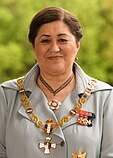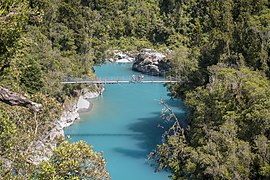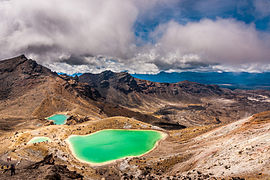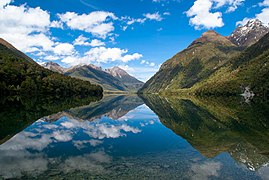New Zealand
New Zealand Aotearoa (Māori) | |
|---|---|
parliamentary constitutional monarchy | |
• Monarch | Charles III |
| Cindy Kiro | |
| Christopher Luxon | |
| Legislature | Parliament (House of Representatives) |
| Stages of independence from the United Kingdom | |
| 6 February 1840 | |
| 7 May 1856 | |
• Dominion | 26 September 1907 |
| 25 November 1947 | |
| 1 January 1987 | |
| Area | |
• Total | 268,021[6] km2 (103,483 sq mi) (75th) |
• Water (%) | 1.6[n 5] |
| Population | |
• April 2024 estimate | |
• 2018 census | |
• Density | 19.5/km2 (50.5/sq mi) (167th) |
| GDP (PPP) | 2023 estimate |
• Total | |
• Per capita | |
| GDP (nominal) | 2023 estimate |
• Total | |
• Per capita | |
| Gini (2022) | medium |
| HDI (2022) | very high (16th) |
| Currency | New Zealand dollar ($) (NZD) |
| Time zone | UTC+12 (NZST[n 6]) |
• Summer (DST) | UTC+13 (NZDT[n 7]) |
| Date format | dd/mm/yyyy[14] |
| Driving side | left |
| Calling code | +64 |
| ISO 3166 code | NZ |
| Internet TLD | .nz |
New Zealand (Māori: Aotearoa [aɔˈtɛaɾɔa]) is an island country in the southwestern Pacific Ocean. It consists of two main landmasses—the North Island (Te Ika-a-Māui) and the South Island (Te Waipounamu)—and over 700 smaller islands. It is the sixth-largest island country by area and lies east of Australia across the Tasman Sea and south of the islands of New Caledonia, Fiji, and Tonga. The country's varied topography and sharp mountain peaks, including the Southern Alps, owe much to tectonic uplift and volcanic eruptions. New Zealand's capital city is Wellington, and its most populous city is Auckland.
The islands of New Zealand were the last large habitable land to be settled by humans. Between about 1280 and 1350, Polynesians began to settle in the islands and then subsequently developed a distinctive Māori culture. In 1642, the Dutch explorer Abel Tasman became the first European to sight and record New Zealand. In 1769 the British explorer Captain James Cook became the first European to set foot on and map New Zealand. In 1840, representatives of the United Kingdom and Māori chiefs signed the Treaty of Waitangi, which in its English version declared British sovereignty over the islands. In 1841, New Zealand became a colony within the British Empire. Subsequently, a series of conflicts between the colonial government and Māori tribes resulted in the alienation and confiscation of large amounts of Māori land. New Zealand became a dominion in 1907; it gained full statutory independence in 1947, retaining the monarch as head of state. Today, the majority of New Zealand's population of 5.25 million is of European descent; the indigenous Māori are the largest minority, followed by Asians and Pasifika. Reflecting this, New Zealand's culture is mainly derived from Māori and early British settlers, with recent broadening of culture arising from increased immigration. The official languages are English, Māori, and New Zealand Sign Language, with the local dialect of English being dominant.
A
Nationally, legislative authority is vested in an elected, unicameral Parliament, while executive political power is exercised by the Government, led by the prime minister, currently Christopher Luxon. Charles III is the country's king and is represented by the governor-general, Cindy Kiro. In addition, New Zealand is organised into 11 regional councils and 67 territorial authorities for local government purposes. The Realm of New Zealand also includes Tokelau (a dependent territory); the Cook Islands and Niue (self-governing states in free association with New Zealand); and the Ross Dependency, which is New Zealand's territorial claim in Antarctica.
New Zealand is a member of the
Etymology

The first European visitor to New Zealand, Dutch explorer
This was written as Nu Tireni in the Māori language (spelled Nu Tirani in Te Tiriti o Waitangi). In 1834 a document written in Māori and entitled "He Wakaputanga o te Rangatiratanga o Nu Tireni" was translated into English and became the Declaration of the Independence of New Zealand. It was prepared by Te W(h)akaminenga o Nga Rangatiratanga o Nga Hapu o Nu Tireni, the United Tribes of New Zealand, and a copy was sent to King William IV who had already acknowledged the flag of the United Tribes of New Zealand, and who recognised the declaration in a letter from Lord Glenelg.[22][23]
In Moriori, the indigenous language of the Chatham Islands, the words Aote and Aotea are terms thought to refer to mainland New Zealand.[32][33]
History
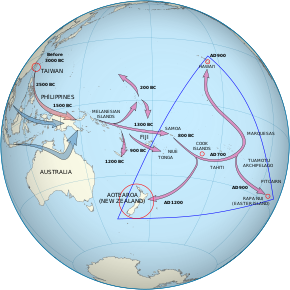
New Zealand was the last major landmass settled by humans. The story of Kupe as the first human to set foot on the New Zealand archipelago, accredited to by most Māori iwi, is considered credible by historians; he is generally believed to have existed historically.[37] Most histories claim that this occurred approximately 40 generations ago (between 900 and 1200 AD).[38] The more specific reasons for Kupe's semi-legendary journey, and the migration of Māori in general, are contested. It is thought by some historians that Hawaiki and other Polynesian islands were experiencing considerable internal conflict at that time, which is thought to have caused an exodus from them. Some historians contend that this was because of the fallout from the 1257 Samalas eruption, which caused crop devastation globally and possibly helped trigger the Little Ice Age.[39][40]
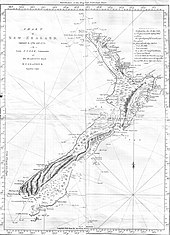
In a hostile 1642 encounter between Ngāti Tūmatakōkiri and Dutch explorer Abel Tasman's crew,[54][55] four of Tasman's crew members were killed, and at least one Māori was hit by canister shot.[56] Europeans did not revisit New Zealand until 1769, when British explorer James Cook mapped almost the entire coastline.[55] Following Cook, New Zealand was visited by numerous European and North American whaling, sealing, and trading ships. They traded European food, metal tools, weapons, and other goods for timber, Māori food, artefacts, and water.[57] The introduction of the potato and the musket transformed Māori agriculture and warfare. Potatoes provided a reliable food surplus, which enabled longer and more sustained military campaigns.[58] The resulting intertribal Musket Wars encompassed over 600 battles between 1801 and 1840, killing 30,000–40,000 Māori.[59] From the early 19th century, Christian missionaries began to settle New Zealand, eventually converting most of the Māori population.[60] The Māori population declined to around 40% of its pre-contact level during the 19th century; introduced diseases were the major factor.[61]
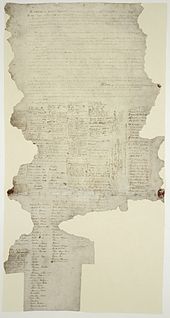
The
New Zealand was administered as a dependency of the Colony of New South Wales until becoming a separate Crown colony, the Colony of New Zealand, on 3 May 1841.[70][71] Armed conflict began between the colonial government and Māori in 1843 with the Wairau Affray over land and disagreements over sovereignty. These conflicts, mainly in the North Island, saw thousands of imperial troops and the Royal Navy come to New Zealand and became known as the New Zealand Wars. Following these armed conflicts, large areas of Māori land were confiscated by the government to meet settler demands.[72]

The colony gained a representative government in 1852, and the first Parliament met in 1854.[73] In 1856 the colony effectively became self-governing, gaining responsibility over all domestic matters (except native policy, which was granted in the mid-1860s).[73] Following concerns that the South Island might form a separate colony, premier Alfred Domett moved a resolution to transfer the capital from Auckland to a locality near Cook Strait.[74][75] Wellington was chosen for its central location, with Parliament officially sitting there for the first time in 1865.[76]
In 1886, New Zealand annexed the volcanic
In 1891 the Liberal Party came to power as the first organised political party.[79] The Liberal Government, led by Richard Seddon for most of its period in office,[80] passed many important social and economic measures. In 1893 New Zealand was the first nation in the world to grant all women the right to vote[79] and in 1894 pioneered the adoption of compulsory arbitration between employers and unions.[81] The Liberals also guaranteed a minimum wage in 1894, a world first.[82]
In 1907, at the request of the New Zealand Parliament, King
Early in the 20th century, New Zealand was involved in world affairs, fighting in the
Government and politics
New Zealand is a
The

A
New Zealand's judiciary, headed by the chief justice,[111] includes the Supreme Court, Court of Appeal, the High Court, and subordinate courts.[112] Judges and judicial officers are appointed non-politically and under strict rules regarding tenure to help maintain judicial independence.[95] This theoretically allows the judiciary to interpret the law based solely on the legislation enacted by Parliament without other influences on their decisions.[113]
New Zealand is identified as one of the world's most stable and well-governed states.
Foreign relations and military

During the period of the New Zealand colony, Britain was responsible for external trade and foreign relations. In 1951, the United Kingdom became increasingly focused on its European interests,[128] while New Zealand joined Australia and the United States in the ANZUS security treaty.[129] The influence of the United States on New Zealand weakened following protests over the Vietnam War,[130] the refusal of the United States to admonish France after the sinking of the Rainbow Warrior,[131] disagreements over environmental and agricultural trade issues, and New Zealand's nuclear-free policy.[132][133] Despite the United States's suspension of ANZUS obligations, the treaty remained in effect between New Zealand and Australia, whose foreign policy has followed a similar historical trend.[134] Close political contact is maintained between the two countries, with free trade agreements and travel arrangements that allow citizens to visit, live and work in both countries without restrictions.[135] In 2013[update] there were about 650,000 New Zealand citizens living in Australia, which is equivalent to 15% of the population of New Zealand.[136]
New Zealand has a strong presence among the 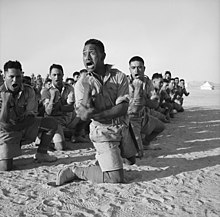
In addition to Vietnam and the two world wars, New Zealand fought in the
Today, New Zealand enjoys
Local government and external territories

The early European settlers divided New Zealand into provinces, which had a degree of autonomy.[164] Because of financial pressures and the desire to consolidate railways, education, land sales, and other policies, government was centralised and the provinces were abolished in 1876.[165] The provinces are remembered in regional public holidays[166] and sporting rivalries.[167]
Since 1876, various councils have administered local areas under legislation determined by the central government.
The Realm of New Zealand, one of 15 Commonwealth realms,[174] is the entire area over which the king or queen of New Zealand is sovereign and comprises New Zealand, Tokelau, the Ross Dependency, the Cook Islands, and Niue.[94] The Cook Islands and Niue are self-governing states in free association with New Zealand.[175][176] The New Zealand Parliament cannot pass legislation for these countries, but with their consent can act on behalf of them in foreign affairs and defence. Tokelau is classified as a non-self-governing territory, but is administered by a council of three elders (one from each Tokelauan atoll).[177] The Ross Dependency is New Zealand's territorial claim in Antarctica, where it operates the Scott Base research facility.[178] New Zealand nationality law treats all parts of the realm equally, so most people born in New Zealand, the Cook Islands, Niue, Tokelau, and the Ross Dependency are New Zealand citizens.[179][n 8]
Geography and environment
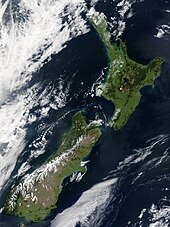
New Zealand is located near the centre of the
New Zealand is long and narrow—over 1,600 kilometres (990 mi) along its north-north-east axis with a maximum width of 400 kilometres (250 mi)[186]—with about 15,000 km (9,300 mi) of coastline[187] and a total land area of 268,000 square kilometres (103,500 sq mi).[188] Because of its far-flung outlying islands and long coastline, the country has extensive marine resources. Its exclusive economic zone is one of the largest in the world, covering more than 15 times its land area.[189]
The South Island is the largest landmass of New Zealand. It is divided along its length by the
The country owes its varied topography, and perhaps even its emergence above the waves, to the dynamic boundary it straddles between the
New Zealand, together with Australia, is part of a region known as Australasia.[199] It also forms the southwestern extremity of the geographic and ethnographic region called Polynesia.[200] Oceania is a wider region encompassing the Australian continent, New Zealand, and various island countries in the Pacific Ocean that are not included in the seven-continent model.[201]
- Landscapes of New Zealand
-
Rural scene near Queenstown
-
West Coast
-
The Emerald Lakes, Mount Tongariro
-
Pencarrow Head, Wellington
Climate

New Zealand's climate is predominantly temperate
| Location | January high °C (°F) |
January low °C (°F) |
July high °C (°F) |
July low °C (°F) |
Annual rainfall mm (in) |
|---|---|---|---|---|---|
| Auckland | 23 (73) | 15 (59) | 15 (59) | 8 (46) | 1,212 (47.7) |
| Wellington | 20 (68) | 14 (57) | 11 (52) | 6 (43) | 1,207 (47.5) |
| Hokitika | 20 (68) | 12 (54) | 12 (54) | 3 (37) | 2,901 (114.2) |
| Christchurch | 23 (73) | 12 (54) | 11 (52) | 2 (36) | 618 (24.3) |
| Alexandra | 25 (77) | 11 (52) | 8 (46) | −2 (28) | 359 (14.1) |
Biodiversity
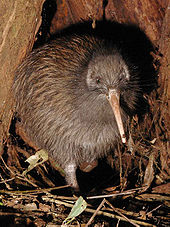
New Zealand's
Before the arrival of humans, an estimated 80% of the land was covered in forest, with only high alpine, wet, infertile and volcanic areas without trees.[219] Massive deforestation occurred after humans arrived, with around half the forest cover lost to fire after Polynesian settlement.[220] Much of the remaining forest fell after European settlement, being logged or cleared to make room for pastoral farming, leaving forest occupying only 23% of the land.[221]

The forests were dominated by
Other indigenous animals are represented by reptiles (
Since human arrival, almost half of the country's vertebrate species have become extinct, including at least fifty-one birds, three frogs, three lizards, one freshwater fish, and one bat. Others are endangered or have had their range severely reduced.[223] However, New Zealand conservationists have pioneered several methods to help threatened wildlife recover, including island sanctuaries, pest control, wildlife translocation, fostering and ecological restoration of islands and other protected areas.[235][236][237][238]
Economy
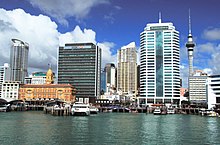
New Zealand has an
Historically, extractive industries have contributed strongly to New Zealand's economy, focusing at different times on sealing, whaling,
Unemployment peaked just above 10% in 1991 and 1992,
Poverty in New Zealand is characterised by growing income inequality; wealth in New Zealand is highly concentrated,[267] with the top 1% of the population owning 16% of the country's wealth, and the richest 5% owning 38%, leaving a stark contrast where half the population, including state beneficiaries and pensioners, receive less than $24,000.[268] Moreover, child poverty in New Zealand has been identified by the Government as a major societal issue;[269][270] the country has 12.0% of children living in low-income households that had less than 50 percent of the median equivalised disposable household income as of June 2022[update].[271] Poverty has a disproportionately high effect in ethnic-minority households, with a quarter (23.3%) of Māori children and almost a third (28.6%) of Pacific Islander children living in poverty as of 2020[update].[269]
Trade
New Zealand is heavily dependent on international trade,
The service sector is the largest sector in the economy, followed by manufacturing and construction and then farming and raw material extraction.[187] Tourism plays a significant role in the economy, contributing $12.9 billion (or 5.6%) to New Zealand's total GDP and supporting 7.5% of the total workforce in 2016.[281] In 2017, international visitor arrivals were expected to increase at a rate of 5.4% annually up to 2022.[281]
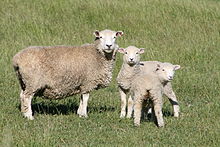
Wool was New Zealand's major agricultural export during the late 19th century.[244] Even as late as the 1960s it made up over a third of all export revenues,[244] but since then its price has steadily dropped relative to other commodities,[282] and wool is no longer profitable for many farmers.[283] In contrast, dairy farming increased, with the number of dairy cows doubling between 1990 and 2007,[284] to become New Zealand's largest export earner.[285] In the year to June 2018, dairy products accounted for 17.7% ($14.1 billion) of total exports,[275] and the country's largest company, Fonterra, controls almost one-third of the international dairy trade.[286] Other exports in 2017–18 were meat (8.8%), wood and wood products (6.2%), fruit (3.6%), machinery (2.2%) and wine (2.1%).[275] New Zealand's wine industry has followed a similar trend to dairy, the number of vineyards doubling over the same period,[287] overtaking wool exports for the first time in 2007.[288][289]
Infrastructure
In 2015,
The provision of water supply and sanitation is generally of good quality. Regional authorities provide water abstraction, treatment and distribution infrastructure to most developed areas.[291][292]
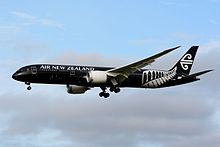
New Zealand's transport network comprises 94,000 kilometres (58,410 mi) of roads, including 199 kilometres (124 mi) of motorways,[293] and 4,128 kilometres (2,565 mi) of railway lines.[187] Most major cities and towns are linked by bus services, although the private car is the predominant mode of transport.[294] The railways were privatised in 1993 but were re-nationalised by the government in stages between 2004 and 2008. The state-owned enterprise KiwiRail now operates the railways, with the exception of commuter services in Auckland and Wellington, which are operated by Auckland One Rail and Transdev Wellington respectively.[295] Railways run the length of the country, although most lines now carry freight rather than passengers.[296] The road and rail networks in the two main islands are linked by roll-on/roll-off ferries between Wellington and Picton, operated by Interislander (part of KiwiRail) and Bluebridge. Most international visitors arrive via air.[297] New Zealand has four international airports: Auckland, Christchurch, Queenstown and Wellington; however, only Auckland and Christchurch offer non-stop flights to countries other than Australia or Fiji.[298]
The
Science and technology
Early indigenous contribution to science in New Zealand was by Māori tohunga accumulating knowledge of agricultural practice and the effects of herbal remedies in the treatment of illness and disease.[303] Cook's voyages in the 1700s and Darwin's in 1835 had important scientific botanical and zoological objectives.[304] The establishment of universities in the 19th century fostered scientific discoveries by notable New Zealanders including Ernest Rutherford for splitting the atom, William Pickering for rocket science, Maurice Wilkins for helping discover DNA, Beatrice Tinsley for galaxy formation, Archibald McIndoe for plastic surgery, and Alan MacDiarmid for conducting polymers.[305]
Crown Research Institutes (CRIs) were formed in 1992 from existing government-owned research organisations. Their role is to research and develop new science, knowledge, products and services across the economic, environmental, social and cultural spectrum for the benefit of New Zealand.[306] The total gross expenditure on research and development (R&D) as a proportion of GDP rose to 1.37% in 2018, up from 1.23% in 2015. New Zealand ranks 21st in the OECD for its gross R&D spending as a percentage of GDP.[307] New Zealand was ranked 27th in the Global Innovation Index in 2023.[308]
The New Zealand Space Agency was created by the government in 2016 for space policy, regulation and sector development. Rocket Lab was the notable first commercial rocket launcher in the country.[309]
The majority of private and commercial research organisations in New Zealand are focused on the agricultural and fisheries sectors. Examples include the Cawthron Institute, the Livestock Improvement Corporation, the Fonterra Research and Development Centre, the Bragato Research Institute, the Kiwifruit Breeding Centre, and B+LNZ Genetics.
Demography
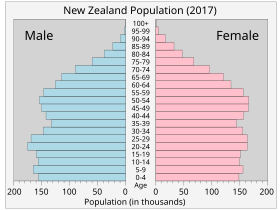
The 2018 New Zealand census enumerated a resident population of 4,699,755, an increase of 10.8% over the 2013 census figure.[3] As of April 2024, the total population has risen to an estimated 5,348,040.[8] New Zealand's population increased at a rate of 1.9% per year in the seven years ended June 2020. In September 2020 Statistics New Zealand reported that the population had climbed above 5 million people in September 2019, according to population estimates based on the 2018 census.[310][n 9]
New Zealand's population today is concentrated to the north of the country, with around 76.5% of the population living in the North Island and 23.5% in the South Island as of June 2023.[312] During the 20th century, New Zealand's population drifted north. In 1921, the country's median centre of population was located in the Tasman Sea west of Levin in Manawatū-Whanganui; by 2017, it had moved 280 km (170 mi) north to near Kawhia in Waikato.[313]
New Zealand is a predominantly urban country, with 84.2% of the population living in
The
Largest cities or towns in New Zealand
Statistics New Zealand June 2023 estimate (SSGA18 boundaries)[312] | |||||||||
|---|---|---|---|---|---|---|---|---|---|
| Rank | Name | Region | Pop. | Rank | Name | Region | Pop. | ||
 Auckland  Christchurch |
1 | Auckland | Auckland | 1,478,800 | 11 | Porirua | Wellington | 60,900 |  Wellington  Hamilton |
| 2 | Christchurch | Canterbury | 384,800 | 12 | New Plymouth | Taranaki | 59,600 | ||
| 3 | Wellington | Wellington | 215,200 | 13 | Rotorua | Bay of Plenty | 58,900 | ||
| 4 | Hamilton | Waikato | 185,300 | 14 | Whangārei | Northland | 56,900 | ||
| 5 | Tauranga | Bay of Plenty | 161,800 | 15 | Nelson | Nelson | 51,900 | ||
| 6 | Lower Hutt | Wellington | 113,000 | 16 | Hastings | Hawke's Bay |
51,500 | ||
| 7 | Dunedin | Otago | 106,200 | 17 | Invercargill | Southland | 51,000 | ||
| 8 | Palmerston North | Manawatū-Whanganui | 82,500 | 18 | Upper Hutt | Wellington | 45,400 | ||
| 9 | Napier | Hawke's Bay |
67,500 | 19 | Whanganui | Manawatū-Whanganui | 42,800 | ||
| 10 | Hibiscus Coast | Auckland | 63,400 | 20 | Gisborne | Gisborne | 38,200 | ||
Ethnicity and immigration
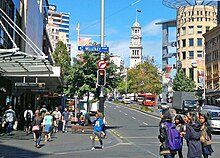
In the 2018 census, 71.8% of New Zealand residents identified ethnically as European, and 16.5% as Māori. Other major ethnic groups include Asian (15.3%) and Pacific peoples (9.0%), two-thirds of whom live in the Auckland Region.[n 3][3] The population has become more multicultural and diverse in recent decades: in 1961, the census reported that the population of New Zealand was 92% European and 7% Māori, with Asian and Pacific minorities sharing the remaining 1%.[322]
While the demonym for a New Zealand citizen is New Zealander, the informal "Kiwi" is commonly used both internationally[323] and by locals.[324] The Māori loanword Pākehā has been used to refer to New Zealanders of European descent, although some reject this name. The word today is increasingly used to refer to all non-Polynesian New Zealanders.[325]
The Māori were the first people to reach New Zealand, followed by the early
Language
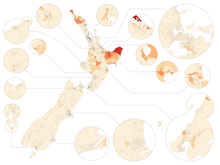
English is the predominant language in New Zealand, spoken by 95.4% of the population.[3] New Zealand English is a variety of the language with a distinctive accent and lexicon.[336] It is similar to Australian English, and many speakers from the Northern Hemisphere are unable to tell the accents apart.[337] The most prominent differences between the New Zealand English dialect and other English dialects are the shifts in the short front vowels: the short-i sound (as in kit) has centralised towards the schwa sound (the a in comma and about); the short-e sound (as in dress) has moved towards the short-i sound; and the short-a sound (as in trap) has moved to the short-e sound.[338]
After the Second World War, Māori were discouraged or forced from speaking their own language (
As recorded in the 2018 census,[3] Samoan is the most widely spoken non-official language (2.2%), followed by "Northern Chinese" (including Mandarin, 2.0%), Hindi (1.5%), and French (1.2%). New Zealand Sign Language was reported to be understood by 22,986 people (0.5%); it became one of New Zealand's official languages in 2006.[348]
Religion

Education
Primary and secondary schooling is compulsory for children aged 6 to 16, with the majority of children attending from the age of 5.[353] There are 13 school years and attending state (public) schools is free to New Zealand citizens and permanent residents from a person's 5th birthday to the end of the calendar year following their 19th birthday.[354] New Zealand has an adult literacy rate of 99%,[187] and over half of the population aged 15 to 29 hold a tertiary qualification.[353] There are five types of government-owned tertiary institutions: universities, colleges of education, polytechnics, specialist colleges, and wānanga,[355] in addition to private training establishments.[356] In 2021, in the population aged 25–64; 13% had no formal qualification, 21% had a school qualification, 28% had a tertiary certificate or diploma, and 35% have a bachelor's degree or higher.[357] The OECD's Programme for International Student Assessment ranks New Zealand as the 28th best in the OECD for maths, 13th best for science, and 11th best for reading.[358]
Culture
Early Māori adapted the tropically based east Polynesian culture in line with the challenges associated with a larger and more diverse environment, eventually developing their own distinctive culture. Social organisation was largely communal with families (whānau), subtribes (hapū) and tribes (iwi) ruled by a chief (rangatira), whose position was subject to the community's approval.[359] The British and Irish immigrants brought aspects of their own culture to New Zealand and also influenced Māori culture,[360][361] particularly with the introduction of Christianity.[362] However, Māori still regard their allegiance to tribal groups as a vital part of their identity, and Māori kinship roles resemble those of other Polynesian peoples.[363] More recently, American, Australian, Asian and other European cultures have exerted influence on New Zealand. Non-Māori Polynesian cultures are also apparent, with Pasifika, the world's largest Polynesian festival, now an annual event in Auckland.[364]
The largely rural life in early New Zealand led to the image of New Zealanders being rugged, industrious problem solvers.[365] Modesty was expected and enforced through the "tall poppy syndrome", where high achievers received harsh criticism.[366] At the time, New Zealand was not known as an intellectual country.[367] From the early 20th century until the late 1960s, Māori culture was suppressed by the attempted assimilation of Māori into British New Zealanders.[339] In the 1960s, as tertiary education became more available, and cities expanded[368] urban culture began to dominate.[369] However, rural imagery and themes are common in New Zealand's art, literature and media.[370]
New Zealand's national symbols are influenced by natural, historical, and Māori sources. The silver fern is an emblem appearing on army insignia and sporting team uniforms.[371] Certain items of popular culture thought to be unique to New Zealand are called "Kiwiana".[371]
Art
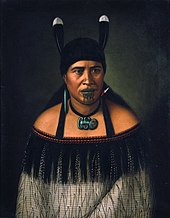
As part of the resurgence of Māori culture, the traditional crafts of carving and weaving are now more widely practised, and Māori artists are increasing in number and influence.[372] Most Māori carvings feature human figures, generally with three fingers and either a natural-looking, detailed head or a grotesque head.[373] Surface patterns consisting of spirals, ridges, notches and fish scales decorate most carvings.[374] The pre-eminent Māori architecture consisted of carved meeting houses (wharenui) decorated with symbolic carvings and illustrations. These buildings were originally designed to be constantly rebuilt, changing and adapting to different whims or needs.[375]
Māori decorated the white wood of buildings, canoes and cenotaphs using red (a mixture of red ochre and shark fat) and black (made from soot) paint and painted pictures of birds, reptiles and other designs on cave walls.[376] Māori tattoos (moko) consisting of coloured soot mixed with gum were cut into the flesh with a bone chisel.[377] Since European arrival paintings and photographs have been dominated by landscapes, originally not as works of art but as factual portrayals of New Zealand.[378] Portraits of Māori were also common, with early painters often portraying them as an ideal race untainted by civilisation.[378] The country's isolation delayed the influence of European artistic trends allowing local artists to develop their own distinctive style of regionalism.[379] During the 1960s and 1970s, many artists combined traditional Māori and Western techniques, creating unique art forms.[380] New Zealand art and craft has gradually achieved an international audience, with exhibitions in the Venice Biennale in 2001 and the "Paradise Now" exhibition in New York in 2004.[372][381]
Māori cloaks are made of fine flax fibre and patterned with black, red and white triangles, diamonds and other geometric shapes.[382] Greenstone was fashioned into earrings and necklaces, with the most well-known design being the hei-tiki, a distorted human figure sitting cross-legged with its head tilted to the side.[383] Europeans brought English fashion etiquette to New Zealand, and until the 1950s most people dressed up for social occasions.[384] Standards have since relaxed and New Zealand fashion has received a reputation for being casual, practical and lacklustre.[385][386] However, the local fashion industry has grown significantly since 2000, doubling exports and increasing from a handful to about 50 established labels, with some labels gaining international recognition.[386]
Literature
Māori quickly adopted writing as a means of sharing ideas, and many of their oral stories and poems were converted to the written form.[387] Most early English literature was obtained from Britain, and it was not until the 1950s when local publishing outlets increased that New Zealand literature started to become widely known.[388] Although still largely influenced by global trends (modernism) and events (the Great Depression), writers in the 1930s began to develop stories increasingly focused on their experiences in New Zealand. During this period, literature changed from a journalistic activity to a more academic pursuit.[389] Participation in the world wars gave some New Zealand writers a new perspective on New Zealand culture and with the post-war expansion of universities local literature flourished.[390] Dunedin is a UNESCO City of Literature.[391]
Media and entertainment
New Zealand music has been influenced by

Public radio was introduced in New Zealand in 1922.[403] A state-owned television service began in 1960.[404] Deregulation in the 1980s saw a sudden increase in the numbers of radio and television stations.[405] New Zealand television primarily broadcasts American and British programming, along with many Australian and local shows.[406] The number of New Zealand films significantly increased during the 1970s. In 1978 the New Zealand Film Commission started assisting local film-makers, and many films attained a world audience, some receiving international acknowledgement.[405] The highest-grossing New Zealand films are Hunt for the Wilderpeople, Boy, The World's Fastest Indian, Whale Rider, Once Were Warriors, Heavenly Creatures and The Piano.[407] The country's diverse scenery and compact size, plus government incentives,[408] have encouraged some producers to shoot very big-budget and well known productions in New Zealand, including The Lord of the Rings and The Hobbit film trilogies, Avatar, The Chronicles of Narnia, King Kong, Wolverine, The Last Samurai and The Power of the Dog.[409] The New Zealand media industry is dominated by a small number of companies, most of which are foreign-owned, although the state retains ownership of some television and radio stations.[410] Since 1994, Freedom House has consistently ranked New Zealand's press freedom in the top twenty, with the 19th freest media as of 2015.[update][411]
Sport
Most of the major sporting codes played in New Zealand have British origins.
New Zealand has competitive international teams in
Cuisine

The national cuisine has been described as
See also
- List of New Zealand-related topics
- Outline of New Zealand
Footnotes
- ^ "God Save the King" is officially a national anthem but is generally used only on regal and viceregal occasions.[1]
- ^ English is a de facto official language due to its widespread use.[2]
- ^ a b Ethnicity figures add to more than 100% as people could choose more than one ethnic group.
- ^ Excluding the Māori-based Rātana and Ringatū churches
- ^ The proportion of New Zealand's area (excluding estuaries) covered by rivers, lakes and ponds, based on figures from the New Zealand Land Cover Database,[7] is (357526 + 81936) / (26821559 – 92499–26033 – 19216)=1.6%. If estuarine open water, mangroves, and herbaceous saline vegetation are included, the figure is 2.2%.
- ^ The Chatham Islands have a separate time zone, 45 minutes ahead of the rest of New Zealand.
- ^ Clocks are advanced by an hour from the last Sunday in September until the first Sunday in April.[13] Daylight saving time is also observed in the Chatham Islands, 45 minutes ahead of NZDT.
- ^ A person born on or after 1 January 2006 acquires New Zealand citizenship at birth only if at least one parent is a New Zealand citizen or permanent resident. All persons born on or before 31 December 2005 acquired citizenship at birth (jus soli).[180]
- ^ A provisional estimate initially indicated the milestone was reached six months later in March 2020, before population estimates were rebased from the 2013 census to the 2018 census.[311]
- ^ In 2015, 55% of Māori adults (aged 15 years and over) reported knowledge of te reo Māori. Of these speakers, 64% use Māori at home and 50,000 can speak the language "very well" or "well".[345]
- ^ Religion percentages may not add to 100% as people could claim multiple religions or object to answering the question.
- ^ This is a percentage of total respondents to the census, not a percentage of Christians.
Citations
- ^ "Protocol for using New Zealand's National Anthems". Ministry for Culture and Heritage. Archived from the original on 11 May 2011. Retrieved 17 February 2008.
- ^ International Covenant on Civil and Political Rights Fifth Periodic Report of the Government of New Zealand (PDF) (Report). New Zealand Government. 21 December 2007. p. 89. Archived from the original (PDF) on 24 January 2015. Retrieved 18 November 2015.
In addition to the Māori language, New Zealand Sign Language is also an official language of New Zealand. The New Zealand Sign Language Act 2006 permits the use of NZSL in legal proceedings, facilitates competency standards for its interpretation and guides government departments in its promotion and use. English, the medium for teaching and learning in most schools, is a de facto official language by virtue of its widespread use. For these reasons, these three languages have special mention in the New Zealand Curriculum.
- ^ a b c d e f g h i j "Quick stats about ethnicity for New Zealand (2018 Census)". Statistics New Zealand. Source: Stats NZ and licensed by Stats NZ for reuse under the Creative Commons Attribution 4.0 International licence. Archived from the original on 14 November 2023. Retrieved 14 November 2023.
- ^ "Quick stats about religion for New Zealand (2018 Census)". Statistics New Zealand. Source: Stats NZ and licensed by Stats NZ for reuse under the Creative Commons Attribution 4.0 International licence. Archived from the original on 14 November 2023. Retrieved 14 November 2023.
- ^ "Treaty of Waitangi". mch.govt.nz. Manatū Taonga Ministry for Culture and Heritage. Archived from the original on 22 June 2023. Retrieved 22 June 2023.
- ^ "New Zealand country profile". BBC News. 20 November 2023. Archived from the original on 5 February 2024. Retrieved 20 November 2023.
- ^ "The New Zealand Land Cover Database". New Zealand Land Cover Database 2. Ministry for the Environment. 1 July 2009. Archived from the original on 14 March 2011. Retrieved 26 April 2011.
- ^ a b "Population clock". Statistics New Zealand. Archived from the original on 19 November 2022. Retrieved 15 May 2021. The population estimate shown is automatically calculated daily at 00:00 UTC and is based on data obtained from the population clock on the date shown in the citation.
- ^ "2018 Census population and dwelling counts". Statistics New Zealand. 23 September 2019. Archived from the original on 7 March 2023. Retrieved 25 September 2019.
- ^ a b c d "World Economic Outlook Database, October 2023 Edition. (NZ)". International Monetary Fund. 10 October 2023. Archived from the original on 19 October 2023. Retrieved 12 October 2023.
- ^ Household income and housing-cost statistics: Year ended June 2022. Statistics New Zealand. 23 March 2023. Archived from the original on 7 October 2023. Retrieved 22 September 2023.
- ^ "Human Development Report 2023/24" (PDF). United Nations Development Programme. 13 March 2024. p. 288. Retrieved 13 March 2024.
- ^ "New Zealand Daylight Time Order 2007 (SR 2007/185)". New Zealand Parliamentary Counsel Office. 6 July 2007. Archived from the original on 7 March 2017. Retrieved 6 March 2017.
- ^ There is no official all-numeric date format for New Zealand, but government recommendations generally follow Australian date and time notation. See The Govt.nz style guide, New Zealand Government, 22 July 2020, archived from the original on 25 July 2021, retrieved 9 July 2021.
- ^ a b "22 USC § 2321k – Designation of major non-NATO allies". law.cornell.edu. Legal Information Institute. Archived from the original on 17 September 2012. Retrieved 14 September 2012.
- ^ JSTOR 45235895.
- ^ a b Wilson, John (March 2009). "European discovery of New Zealand – Tasman's achievement". Te Ara: The Encyclopedia of New Zealand. Archived from the original on 6 January 2012. Retrieved 24 January 2011.
- ^ Bathgate, John. "The Pamphlet Collection of Sir Robert Stout: Volume 44. Chapter 1, Discovery and Settlement". NZETC. Archived from the original on 24 July 2020. Retrieved 17 August 2018.
He named the country Staaten Land, in honour of the States-General of Holland, in the belief that it was part of the great southern continent.
- ^ Mackay, Duncan (1986). "The Search for the Southern Land". In Fraser, B. (ed.). The New Zealand Book of Events. Auckland: Reed Methuen. pp. 52–54.
- Frederick Warne & Co. p. iii. Retrieved 10 October 2016.
- ^ a b McKinnon, Malcolm (November 2009). "Place names – Naming the country and the main islands". Te Ara: The Encyclopedia of New Zealand. Archived from the original on 13 June 2018. Retrieved 24 January 2011.
- ^ Grant (Lord Glenelg), Charles (1836). "Extract of a Despatch from Lord Glenelg to Major-General Sir Richard Bourke, New South Wales". Archived from the original on 8 December 2021. Retrieved 20 March 2021 – via Waitangi Associates.
- ^ Palmer 2008, p. 41.
- ^ King 2003, p. 41.
- ^ Hay, Maclagan & Gordon 2008, p. 72.
- ^ a b Mein Smith 2005, p. 6.
- ^ Brunner, Thomas (1851). The Great Journey: An expedition to explore the interior of the Middle Island, New Zealand, 1846-8. Royal Geographical Society. Archived from the original on 31 October 2021. Retrieved 13 June 2010.
- ^ a b Williamson, Maurice (10 October 2013). "Names of NZ's two main islands formalised" (Press release). New Zealand Government. Archived from the original on 8 October 2014. Retrieved 1 May 2017.
- ^ Ministry of Health (24 June 2021). "COVID-19: Elimination strategy for Aotearoa New Zealand". Archived from the original on 2 December 2021. Retrieved 15 July 2021.
- .
- ^ "Using 'Aotearoa' and 'New Zealand' together 'as it should be' - Jacinda Ardern". Newshub. 17 December 2019. Archived from the original on 18 July 2021. Retrieved 18 July 2021.
- ^ New Zealand Government. "Moriori and the Trustees of the Moriori Imi Settlement Trust and the Crown Deed of Settlement of Historical Claims" (PDF). Archived (PDF) from the original on 6 March 2022. Retrieved 20 July 2023.
- ^ Te Papa (25 August 2020). "Repatriation and return of karāpuna to Rēkohu". Archived from the original on 7 June 2023. Retrieved 20 July 2023.
- S2CID 162638670.
- S2CID 161058755.
- PMID 21187404.
- Museum of New Zealand Te Papa Tongarewa. Archivedfrom the original on 18 July 2023. Retrieved 14 March 2023.
- ^ "Kupe". archive.hokulea.com. Archived from the original on 29 March 2023. Retrieved 24 February 2023.
- ^ "2: Tangata Whenua". RNZ. 8 October 2019. Archived from the original on 24 February 2023. Retrieved 24 February 2023.
- from the original on 6 March 2023. Retrieved 24 May 2023.
- .
- PMID 9671802.
- PMID 18523023.
- from the original on 1 October 2022. Retrieved 22 March 2020.
- .
- ^ Roberton, J. B. W. (1956). "Genealogies as a basis for Maori chronology". Journal of the Polynesian Society. 65 (1): 45–54. Archived from the original on 10 March 2020. Retrieved 22 March 2020.
- ^ Te Hurinui, Pei (1958). "Maori genealogies". Journal of the Polynesian Society. 67 (2): 162–165. Archived from the original on 12 February 2018. Retrieved 22 March 2020.
- PMID 19164753.
- S2CID 254743326.
- ISBN 9780864733283.
- ^ Clark, Ross (1994). "Moriori and Māori: The Linguistic Evidence". In Sutton, Douglas (ed.). The Origins of the First New Zealanders. Auckland: Auckland University Press. pp. 123–135.
- ^ Davis, Denise (September 2007). "The impact of new arrivals". Te Ara: The Encyclopedia of New Zealand. Archived from the original on 19 April 2023. Retrieved 30 April 2010.
- ^ Davis, Denise; Solomon, Māui (March 2009). "Moriori – The impact of new arrivals". Te Ara: The Encyclopedia of New Zealand. Archived from the original on 19 April 2023. Retrieved 23 March 2011.
- ^ Mitchell, Hillary (10 February 2015). "Te Tau Ihu". Te Ara: The Encyclopedia of New Zealand. Ministry for Culture and Heritage. Archived from the original on 28 August 2016. Retrieved 15 September 2016.
- ^ a b Mein Smith 2005, p. 23.
- ISBN 0-670-83298-7.
- ^ King 2003, p. 122.
- ^ Fitzpatrick, John (2004). "Food, warfare and the impact of Atlantic capitalism in Aotearo/New Zealand" (PDF). Australasian Political Studies Association Conference: APSA 2004 Conference Papers. Archived from the original (PDF) on 11 May 2011.
- ISBN 0-456-01060-2.
- ISBN 978-90-04-13899-5.
- ISBN 978-1-86940-214-3.
- ^ a b c Orange, Claudia (1990). "Busby, James – Biography". In Oliver, W. H.; Orange, Claudia; Phillips, Jock (eds.). Dictionary of New Zealand Biography, Te Ara: The Encyclopedia of New Zealand. Archived from the original on 27 June 2013. Retrieved 7 January 2011.
- New Zealand Ministry for Culture and Heritage. 24 December 2020. Archivedfrom the original on 18 October 2021. Retrieved 19 October 2021.
- ^ Foster, Bernard John (April 2009) [1966]. "Sir George Gipps". In McLintock, Alexander Hare (ed.). An Encyclopaedia of New Zealand. Archived from the original on 17 January 2013. Retrieved 20 March 2021 – via TeAra.govt.nz.
- ^ a b Wilson, John (16 September 2016) [2005]. "Nation and government – The origins of nationhood". In Phillips, Jock (ed.). Te Ara: The Encyclopedia of New Zealand. Archived from the original on 24 May 2018. Retrieved 20 March 2021.
- ^ McLintock, Alexander Hare, ed. (April 2009) [1966]. "Settlement from 1840 to 1852". An Encyclopaedia of New Zealand. Archived from the original on 20 January 2013. Retrieved 7 January 2011 – via TeAra.govt.nz.
- ^ Foster, Bernard John (April 2009) [1966]. "Akaroa, French Settlement At". In McLintock, Alexander Hare (ed.). An Encyclopaedia of New Zealand. Archived from the original on 20 January 2013. Retrieved 7 January 2011 – via TeAra.govt.nz.
- ^ Simpson, K. A. (1990). "Hobson, William – Biography". In Oliver, W. H.; Orange, Claudia; Phillips, Jock (eds.). Dictionary of New Zealand Biography, Te Ara: The Encyclopedia of New Zealand. Archived from the original on 20 August 2017. Retrieved 20 March 2021.
- ^ Phillips, Jock (1 August 2015) [2005]. "History of immigration – British immigration and the New Zealand Company". In Phillips, Jock (ed.). Te Ara: The Encyclopedia of New Zealand. Archived from the original on 10 March 2021. Retrieved 20 March 2021.
- New Zealand Ministry for Culture and Heritage. March 2009. Archivedfrom the original on 2 March 2011. Retrieved 7 January 2011.
- ISBN 978-0-95829971-8.
- New Zealand Ministry for Culture and Heritage. April 2009. Archivedfrom the original on 14 November 2016. Retrieved 7 January 2011.
- ^ a b c Wilson, John (16 September 2016) [2005]. "Government and nation – From colony to nation". In Phillips, Jock (ed.). Te Ara: The Encyclopedia of New Zealand. Archived from the original on 26 December 2018. Retrieved 2 February 2011.
- ISBN 0-86868-012-5.
- ^ Levine, Stephen (13 July 2012). "Capital city – A new capital". Te Ara: The Encyclopedia of New Zealand. Archived from the original on 5 May 2015. Retrieved 4 May 2015.
- New Zealand Ministry for Culture and Heritage. January 2017. Archivedfrom the original on 25 April 2019. Retrieved 27 April 2017.
- ^ Jobberns, George (1966). "Kermadec Islands". In McLintock, A. H. (ed.). An Encyclopaedia of New Zealand, Te Ara. Archived from the original on 19 March 2022. Retrieved 18 March 2022.
- ^ "Pacific Island Exclusive Economic Zones". TEARA. Archived from the original on 24 October 2022. Retrieved 24 October 2022.
- ^ a b Wilson, John (March 2009). "History – Liberal to Labour". Te Ara: The Encyclopedia of New Zealand. Archived from the original on 27 April 2017. Retrieved 27 April 2017.
- ^ Hamer, David. "Seddon, Richard John". Dictionary of New Zealand Biography. Ministry for Culture and Heritage. Retrieved 27 April 2017.
- doi:10.1111/1467-8543.00069. Archived from the original(PDF) on 11 May 2011.
- ^ "A brief history of the minimum wage in New Zealand". Newshub. Archived from the original on 19 July 2022. Retrieved 19 July 2022.
- ^ "Proclamation". The London Gazette. No. 28058. 10 September 1907. p. 6149.
- New Zealand Ministry for Culture and Heritage. September 2014. Archivedfrom the original on 14 June 2020. Retrieved 26 April 2017.
- New Zealand Ministry for Culture and Heritage. Archivedfrom the original on 9 November 2016. Retrieved 7 January 2011.
- ^ Easton, Brian (April 2010). "Economic history – Interwar years and the great depression". Te Ara: The Encyclopedia of New Zealand. Archived from the original on 16 May 2011. Retrieved 7 January 2011.
- ^ Derby, Mark (May 2010). "Strikes and labour disputes – Wars, depression and first Labour government". Te Ara: The Encyclopedia of New Zealand. Archived from the original on 23 January 2011. Retrieved 1 February 2011.
- ^ Easton, Brian (November 2010). "Economic history – Great boom, 1935–1966". Te Ara: The Encyclopedia of New Zealand. Archived from the original on 16 May 2011. Retrieved 1 February 2011.
- ^ Keane, Basil (November 2010). "Te Māori i te ohanga – Māori in the economy – Urbanisation". Te Ara: The Encyclopedia of New Zealand. Archived from the original on 16 May 2011. Retrieved 7 January 2011.
- ^ Royal, Te Ahukaramū (March 2009). "Māori – Urbanisation and renaissance". Te Ara: The Encyclopedia of New Zealand. Archived from the original on 20 January 2013. Retrieved 1 February 2011.
- ISBN 978-0-478-32436-5. Archived from the original(PDF) on 27 January 2018. Retrieved 26 April 2017.
- ^ Report on the Crown's Foreshore and Seabed Policy (Report). Ministry of Justice. Archived from the original on 1 February 2019. Retrieved 26 April 2017.
- ^ Barker, Fiona (June 2012). "Debate about the foreshore and seabed". Te Ara: The Encyclopedia of New Zealand. Archived from the original on 18 July 2023. Retrieved 26 April 2017.
- ^ a b "New Zealand's Constitution". Office of the Governor-General of New Zealand. Archived from the original on 6 April 2003. Retrieved 13 January 2010.
- ^ a b c "Factsheet – New Zealand – Political Forces". The Economist. 15 February 2005. Archived from the original on 14 May 2006. Retrieved 4 August 2009.
- New Zealand Parliamentary Counsel Office. February 1974. Section 1. Archivedfrom the original on 20 October 2008. Retrieved 8 January 2011.
- New Zealand Parliamentary Counsel Office. 1 January 1987. Section 2.1. Archivedfrom the original on 23 December 2016. Retrieved 15 July 2018.
The Sovereign in right of New Zealand is the head of State of New Zealand, and shall be known by the royal style and titles proclaimed from time to time.
- ^ "The Role of the Governor-General". Office of the Governor-General of New Zealand. 27 February 2017. Archived from the original on 29 June 2017. Retrieved 6 July 2017.
- ^ Harris, Bruce (2009). "Replacement of the Royal Prerogative in New Zealand". New Zealand Universities Law Review. 23: 285–314. Archived from the original on 18 July 2011. Retrieved 28 August 2016.
- ^ a b "The Reserve Powers". Office of the Governor-General of New Zealand. Archived from the original on 7 July 2017. Retrieved 8 January 2011.
- ^ a b c d "Parliament Brief: What is Parliament?". New Zealand Parliament. Archived from the original on 29 October 2020. Retrieved 30 November 2016.
- ^ McLean, Gavin (February 2015). "Premiers and prime ministers". Te Ara: The Encyclopedia of New Zealand. Archived from the original on 17 May 2017. Retrieved 30 November 2016.
- ^ Wilson, John (November 2010). "Government and nation – System of government". Te Ara: The Encyclopedia of New Zealand. Archived from the original on 16 May 2011. Retrieved 9 January 2011.
- ^ "Principles of Cabinet decision making". Cabinet Manual. Department of the Prime Minister and Cabinet. 2008. Archived from the original on 20 December 2016. Retrieved 1 December 2016.
- ^ "Christopher Luxon sworn in as New Zealand's new prime minister". TVNZ. 1News. 27 November 2023. Archived from the original on 27 November 2023. Retrieved 27 November 2023.
- ^ "The electoral cycle". Cabinet Manual. Department of the Prime Minister and Cabinet. 2008. Archived from the original on 27 January 2018. Retrieved 30 April 2017.
- New Zealand Ministry for Culture and Heritage. September 2009. Archivedfrom the original on 1 July 2010. Retrieved 9 January 2011.
- ^ "Number of electorates and electoral populations: 2018 Census". Stats.Govt.nz. Statistics New Zealand. 23 September 2019. Archived from the original on 13 December 2019. Retrieved 9 March 2021.
- ^ "Sainte-Laguë allocation formula". Electoral Commission. 4 February 2013. Archived from the original on 14 September 2013. Retrieved 31 May 2014.
- ^ Curtin, Jennifer; Miller, Raymond (21 July 2015). "Political parties". Te Ara: The Encyclopedia of New Zealand. Archived from the original on 17 June 2023. Retrieved 24 July 2023.
- ^ "Role of the Chief Justice". Courts of New Zealand. Archived from the original on 25 March 2020. Retrieved 9 June 2018.
- ^ "Structure of the court system". Courts of New Zealand. Archived from the original on 12 June 2018. Retrieved 9 June 2018.
- ^ "The Judiciary". Ministry of Justice. Archived from the original on 24 November 2010. Retrieved 9 January 2011.
- ^ "Fragile States Index Heat Map". Fragile States Index. Archived from the original on 14 August 2020. Retrieved 18 August 2020.
- ^ "Democracy Index 2017" (PDF). Economist Intelligence Unit. 2018. p. 5. Archived (PDF) from the original on 18 February 2018. Retrieved 9 December 2018.
- ^ "Corruption Perceptions Index 2017". Transparency International. 21 February 2018. Archived from the original on 21 February 2018. Retrieved 9 December 2018.
- ^ Carroll, Aengus (May 2016). "State Sponsored Homophobia 2016: A world survey of sexual orientation laws: criminalisation, protection and recognition" (PDF). International Lesbian, Gay, Bisexual, Trans and Intersex Association. p. 183. Archived (PDF) from the original on 2 September 2017. Retrieved 4 December 2016.
In Australia and New Zealand, lesbian, gay, and bisexual people continue to enjoy many legal rights denied to their comrades across the vast majority of the Pacific.
- Organisation for Economic Co-operation and Development. Archivedfrom the original on 21 January 2023. Retrieved 31 January 2023.
- ^ "Council election turnout: Low participation revives call for online voting". RNZ. 10 October 2022. Archived from the original on 29 May 2023. Retrieved 29 May 2023.
- ^ "Auckland councillor says record low local election turnout 'extremely concerning'". NZ Herald. 30 May 2023. Archived from the original on 9 October 2022. Retrieved 29 May 2023.
- ^ "The media and low local election turnout". RNZ. 13 October 2022. Archived from the original on 29 May 2023. Retrieved 29 May 2023.
- ^ "New Zealand". Country Reports on Human Rights Practices for 2017. United States Department of State. Archived from the original on 1 January 2020. Retrieved 9 December 2018.
- ^ "A fair go for all? Rite tahi tätou katoa? Addressing Structural Discrimination in Public Services". Human Rights Commission. 2012. p. 50. Archived from the original on 30 March 2014. Retrieved 22 July 2023.
- ^ Cornish, Sophie (1 May 2022). "Māori even more overrepresented in prisons, despite $98m strategy". Stuff. Archived from the original on 29 May 2023. Retrieved 29 May 2023.
- ^ "Hāpaitia te Oranga Tangata | New Zealand Ministry of Justice". www.justice.govt.nz. Archived from the original on 1 June 2023. Retrieved 29 May 2023.
- ^ McLintock, Alexander, ed. (April 2009) [1966]. "External Relations". An Encyclopaedia of New Zealand. Archived from the original on 20 January 2013. Retrieved 7 January 2011.
- New Zealand Ministry for Culture and Heritage. July 2010. Archivedfrom the original on 27 September 2016. Retrieved 29 January 2011.
- ^ Patman, Robert (2005). "Globalisation, Sovereignty, and the Transformation of New Zealand Foreign Policy" (PDF). Working Paper 21/05. Centre for Strategic Studies, Victoria University of Wellington. p. 8. Archived from the original (PDF) on 25 September 2007. Retrieved 12 March 2007.
- Australian Government. September 1951. Archived from the originalon 29 June 2011. Retrieved 11 January 2011.
- New Zealand Ministry for Culture and Heritage. June 2008. Archivedfrom the original on 8 November 2016. Retrieved 11 January 2011.
- New Zealand Ministry for Culture and Heritage. August 2008. Archivedfrom the original on 19 October 2016. Retrieved 11 January 2011.
- New Zealand Ministry for Culture and Heritage. August 2008. Archivedfrom the original on 3 November 2016. Retrieved 11 January 2011.
- ISBN 0-14-014519-2.
- Australian Department of Foreign Affairs and Trade. Archived from the originalon 22 December 2010. Retrieved 11 January 2011.
- ^ Australian Department of Foreign Affairs and Trade. Archived from the originalon 12 October 2013. Retrieved 11 January 2011.
- ^ Collett, John (4 September 2013). "Kiwis face hurdles in pursuit of lost funds". Archived from the original on 6 September 2013. Retrieved 4 October 2013.
- from the original on 21 February 2024. Retrieved 7 March 2022.
- ^ Bertram, Geoff (April 2010). "South Pacific economic relations – Aid, remittances and tourism". Te Ara: The Encyclopedia of New Zealand. Archived from the original on 20 January 2013. Retrieved 11 January 2011.
- ^ "2018 Census population and dwelling counts". www.stats.govt.nz. Statistics New Zealand. 23 September 2019. § Ethnicity. Retrieved 2 June 2022.
- ^ Howes, Stephen (November 2010). "Making migration work: Lessons from New Zealand". Development Policy Centre. Archived from the original on 11 May 2011. Retrieved 23 March 2011.
- ^ Institute, Lowy. "New Zealand – Lowy Institute Asia Power Index". Lowy Institute Asia Power Index 2021. Archived from the original on 1 April 2022. Retrieved 7 March 2022.
- ^ "Caught between China and the US: The Kiwi place in a newly confrontational world". Stuff.co.nz. 7 June 2019. Archived from the original on 5 July 2019. Retrieved 1 May 2020.
- ^ Steff, Reuben (5 June 2018). "New Zealand's Pacific reset: strategic anxieties about rising China". University of Waikato. Archived from the original on 1 February 2019. Retrieved 1 May 2020.
- ^ "Member States of the United Nations". United Nations. Archived from the original on 30 December 2013. Retrieved 11 January 2011.
- ^ "New Zealand". The Commonwealth. 15 August 2013. Archived from the original on 1 December 2016. Retrieved 1 December 2016.
- Organisation for Economic Co-operation and Development. Archivedfrom the original on 8 April 2011. Retrieved 11 January 2011.
- ^ "The Future of the Five Power Defence Arrangements". The Strategist. Australian Strategic Policy Institute. 8 November 2012. Archived from the original on 2 December 2016. Retrieved 1 December 2016.
- ^ "About Us: Role and Responsibilities". New Zealand Defence Force. Archived from the original on 8 February 2013. Retrieved 11 January 2011.
- ISBN 978-0-86473-548-5.
- New Zealand Ministry for Culture and Heritage. May 2010. Archivedfrom the original on 21 April 2009. Retrieved 9 January 2011.
- New Zealand Ministry for Culture and Heritage. May 2009. Archivedfrom the original on 4 January 2011. Retrieved 9 January 2011.
- ^ Holmes, Richard (September 2010). "World War Two: The Battle of Monte Cassino". Archived from the original on 28 January 2011. Retrieved 9 January 2011.
- ^ "Gallipoli stirred new sense of national identity says Clark". The New Zealand Herald. April 2005. Archived from the original on 29 April 2020. Retrieved 9 January 2011.
- ISBN 978-0-08-045362-0.
- ^ Burke, Arthur. "The Spirit of ANZAC". ANZAC Day Commemoration Committee. Archived from the original on 26 December 2010. Retrieved 11 January 2011.
- New Zealand Ministry for Culture and Heritage. February 2009. Archivedfrom the original on 3 January 2011. Retrieved 11 January 2011.
- New Zealand Ministry for Culture and Heritage. Archivedfrom the original on 9 May 2020. Retrieved 1 December 2016.
- New Zealand Ministry for Culture and Heritage. August 2010. Archivedfrom the original on 3 January 2011. Retrieved 11 January 2011.
- ^ "New Zealand Defence Force Overseas Operations". New Zealand Defence Force. January 2008. Archived from the original on 25 January 2008. Retrieved 17 February 2008.
- ^ "Five Eyes Intelligence Oversight and Review Council (FIORC)". www.dni.gov. Archived from the original on 21 January 2021. Retrieved 12 September 2022.
- ^ "Relations with New Zealand". NATO. Archived from the original on 3 April 2023. Retrieved 3 April 2023.
- ^ "Partnership arrangement signed with NATO". Beehive.co.nz. NZ Govt. Archived from the original on 3 April 2023. Retrieved 3 April 2023.
- ^ Scotcher, Katie (3 April 2023). "New Zealand's relationship to Nato is getting stronger, expert says". New Zealand Herald. Archived from the original on 3 April 2023. Retrieved 3 April 2023.
- ^ a b "New Zealand's Nine Provinces (1853–76)" (PDF). Friends of the Hocken Collections. University of Otago. March 2000. Archived from the original (PDF) on 5 February 2011. Retrieved 13 January 2011.
- ^ McLintock, Alexander, ed. (April 2009) [1966]. "Provincial Divergencies". An Encyclopaedia of New Zealand. Archived from the original on 20 January 2013. Retrieved 7 January 2011.
- ^ Swarbrick, Nancy (September 2016). "Public holidays". Te Ara: The Encyclopedia of New Zealand. Archived from the original on 6 June 2017. Retrieved 25 June 2017.
- New Zealand Ministry for Culture and Heritage. September 2010. Archivedfrom the original on 22 August 2016. Retrieved 13 January 2011.
- ^ Dollery, Brian; Keogh, Ciaran; Crase, Lin (2007). "Alternatives to Amalgamation in Australian Local Government: Lessons from the New Zealand Experience" (PDF). Sustaining Regions. 6 (1): 50–69. Archived from the original (PDF) on 29 August 2007.
- ^ ISBN 0-7735-2163-1.
- ^ "Subnational population estimates at 30 June 2010 (boundaries at 1 November 2010)". Statistics New Zealand. 26 October 2010. Archived from the original on 10 June 2011. Retrieved 2 April 2011.
- ^ Smelt & Jui Lin 2009, p. 33.
- ^ a b "Glossary". Department of Internal Affairs. Archived from the original on 9 July 2023. Retrieved 28 August 2016.
- New Zealand Parliamentary Counsel Office. 29 July 1995. Archivedfrom the original on 8 August 2017. Retrieved 8 August 2017.
- ISBN 978-1-617-14792-0. Retrieved 18 November 2016.
- ^ "System of Government". Government of Niue. Archived from the original on 13 November 2010. Retrieved 13 January 2010.
- ^ "Government – Structure, Personnel". Government of the Cook Islands. Archived from the original on 20 January 2022. Retrieved 13 January 2010.
- ^ "Tokelau Government". Government of Tokelau. Archived from the original on 13 November 2016. Retrieved 16 November 2016.
- ^ "Scott Base". Antarctica New Zealand. Archived from the original on 29 March 2023. Retrieved 13 January 2010.
- ^ "Citizenship Act 1977 No 61". Zealand Parliamentary Counsel Office. 1 December 1977. Archived from the original on 25 February 2017. Retrieved 26 May 2017.
- ^ "Check if you're a New Zealand citizen". Department of Internal Affairs. Archived from the original on 23 September 2014. Retrieved 20 January 2015.
- ^ a b Walrond, Carl (8 February 2005). "Natural environment – Geography and geology". Te Ara: The Encyclopedia of New Zealand. Archived from the original on 21 February 2022. Retrieved 26 December 2020.
- ^ McLintock, Alexander, ed. (April 2009) [1966]. "The Sea Floor". An Encyclopaedia of New Zealand. Archived from the original on 20 January 2013. Retrieved 13 January 2011.
- ^ "Hauraki Gulf islands". Auckland City Council. Archived from the original on 25 December 2010. Retrieved 13 January 2011.
- ^ Hindmarsh (2006). "Discovering D'Urville". Heritage New Zealand. Archived from the original on 11 May 2011. Retrieved 13 January 2011.
- ^ "Distance tables". Auckland Coastguard. Archived from the original on 23 January 2011. Retrieved 2 March 2011.
- ISBN 0-7900-0187-X.
- ^ US Central Intelligence Agency. 25 February 2021. Archivedfrom the original on 9 January 2021. Retrieved 20 March 2021.
- ^ "Geography". Statistics New Zealand. 1999. Archived from the original on 22 May 2010. Retrieved 21 December 2009.
- ISBN 0-478-25916-6. Archived from the original(PDF) on 11 April 2019. Retrieved 23 June 2017.
- ISBN 0-908812-93-0.
- ^ Garden 2005, p. 52.
- ^ Grant, David (March 2009). "Southland places – Fiordland's coast". Te Ara: The Encyclopedia of New Zealand. Archived from the original on 28 June 2012. Retrieved 14 January 2011.
- New Zealand Department of Conservation. Archived from the originalon 29 December 2010. Retrieved 14 January 2011.
- ^ "Taupō". GNS Science. Archived from the original on 24 March 2011. Retrieved 2 April 2011.
- ^ a b Lewis, Keith; Nodder, Scott; Carter, Lionel (March 2009). "Sea floor geology – Active plate boundaries". Te Ara: The Encyclopedia of New Zealand. Archived from the original on 20 January 2013. Retrieved 4 February 2011.
- S2CID 22049973.
- OCLC 887230882.
- S2CID 6072675.
- ISBN 9780195584516.
- ISBN 9781305854956.
- ISBN 9781576076941.
... defined here as the continent nation of Australia, New Zealand, and twenty-two other island countries and territories sprinkled over more than 40 million square kilometres of the South Pacific.
- ^ a b Mullan, Brett; Tait, Andrew; Thompson, Craig (March 2009). "Climate – New Zealand's climate". Te Ara: The Encyclopedia of New Zealand. Archived from the original on 20 January 2013. Retrieved 15 January 2011.
- ^ "Summary of New Zealand climate extremes". National Institute of Water and Atmospheric Research. 2004. Archived from the original on 25 September 2023. Retrieved 30 April 2010.
- ^ Walrond, Carl (March 2009). "Natural environment – Climate". Te Ara: The Encyclopedia of New Zealand. Archived from the original on 20 January 2013. Retrieved 15 January 2011.
- ^ Orange, Claudia (1 May 2015). "Northland region". Te Ara: The Encyclopedia of New Zealand. Archived from the original on 11 August 2020. Retrieved 4 May 2020.
- XLS) on 3 May 2011. Retrieved 4 February 2011.
- XLS) on 15 October 2008. Retrieved 4 February 2011.
- ^ "New Zealand climate and weather". Tourism New Zealand. Archived from the original on 20 October 2016. Retrieved 13 November 2016.
- ^ "Climate data and activities". National Institute of Water and Atmospheric Research. 28 February 2007. Archived from the original on 7 January 2019. Retrieved 11 February 2016.
- PMID 21236222.
- ISBN 9780143568896.
- ISBN 978-1-86950-300-0.
- from the original on 18 August 2021. Retrieved 6 April 2021.
- ^ a b "Frequently asked questions about New Zealand plants". New Zealand Plant Conservation Network. May 2010. Archived from the original on 8 September 2012. Retrieved 15 January 2011.
- ISBN 0-473-11306-6.
- ^ Wassilieff, Maggy (March 2009). "Lichens – Lichens in New Zealand". Te Ara: The Encyclopedia of New Zealand. Archived from the original on 17 January 2013. Retrieved 16 January 2011.
- ^ McLintock, Alexander, ed. (April 2010) [1966]. "Mixed Broadleaf Podocarp and Kauri Forest". An Encyclopaedia of New Zealand. Archived from the original on 17 January 2013. Retrieved 15 January 2011.
- ^ Mark, Alan (March 2009). "Grasslands – Tussock grasslands". Te Ara: The Encyclopedia of New Zealand. Archived from the original on 17 January 2013. Retrieved 17 January 2010.
- ^ "Commentary on Forest Policy in the Asia-Pacific Region (A Review for Indonesia, Malaysia, New Zealand, Papua New Guinea, Philippines, Thailand and Western Samoa)". Forestry Department. 1997. Archived from the original on 7 February 2019. Retrieved 4 February 2011.
- ^ McGlone, M. S. (1989). "The Polynesian settlement of New Zealand in relation to environmental and biotic changes" (PDF). New Zealand Journal of Ecology. 12(S): 115–129. Archived from the original (PDF) on 17 July 2014.
- New Zealand Ministry for the Environment. Archived from the originalon 22 January 2015. Retrieved 6 March 2011.
- ^ "New Zealand ecology: Flightless birds". TerraNature. Archived from the original on 8 April 2020. Retrieved 17 January 2011.
- ^ a b Holdaway, Richard (March 2009). "Extinctions – New Zealand extinctions since human arrival". Te Ara: The Encyclopedia of New Zealand. Archived from the original on 20 January 2013. Retrieved 4 February 2011.
- ^ Kirby, Alex (January 2005). "Huge eagles 'dominated NZ skies'". BBC News. Archived from the original on 4 April 2023. Retrieved 4 February 2011.
- New Zealand Department of Conservation. Archived from the originalon 29 January 2015. Retrieved 25 June 2017.
- ^ Pollard, Simon (September 2007). "Spiders and other arachnids". Te Ara: The Encyclopedia of New Zealand. Archived from the original on 6 June 2017. Retrieved 25 June 2017.
- New Zealand Department of Conservation. Archivedfrom the original on 12 June 2017. Retrieved 25 June 2017.
- ^ Ryan, Paddy (March 2009). "Snails and slugs – Flax snails, giant snails and veined slugs". Te Ara: The Encyclopedia of New Zealand. Archived from the original on 17 January 2013. Retrieved 4 February 2011.
- .
- ^ "Tiny Bones Rewrite Textbooks, first New Zealand land mammal fossil". University of New South Wales. 31 May 2007. Archived from the original on 31 May 2007.
- PMID 17159151.
- New Zealand Department of Conservation. Archived from the originalon 8 March 2011. Retrieved 17 January 2011.
- New Zealand Department of Conservation. Archivedfrom the original on 2 August 2015. Retrieved 7 March 2011.
- New Zealand Department of Conservation. Archivedfrom the original on 15 September 2015. Retrieved 7 March 2011.
- ISBN 0-521-79128-6.
- PMID 21236227.
- ^ Rauzon, Mark (2008). "Island restoration: Exploring the past, anticipating the future" (PDF). Marine Ornithology. 35: 97–107. Archived (PDF) from the original on 6 June 2023. Retrieved 17 January 2011.
- New Zealand Department of Conservation. pp. 3–8. Archived(PDF) from the original on 11 January 2014. Retrieved 26 November 2013 – via Doc.Govt.nz.
- ISBN 978-1-48434-971-7. Archivedfrom the original on 20 June 2018. Retrieved 21 June 2018.
- ISBN 978-9211264517. Archived(PDF) from the original on 9 October 2022. Retrieved 8 September 2022.
- ^ "Country rankings". Index of Economic Freedom. The Heritage Foundation. 2022. Archived from the original on 21 May 2020. Retrieved 14 August 2022.
- ^ "Report for Selected Countries and Subjects: October 2020". International Monetary Fund. Archived from the original on 26 October 2020. Retrieved 21 October 2020.
- ^ "Currencies of the territories listed in the BS exchange rate lists". Bank of Slovenia. Archived from the original on 4 April 2023. Retrieved 22 January 2011.
- ^ a b c McLintock, Alexander, ed. (November 2009) [1966]. "Historical evolution and trade patterns". An Encyclopaedia of New Zealand. Archived from the original on 4 April 2023. Retrieved 10 February 2011.
- ^ Stringleman, Hugh; Peden, Robert (October 2009). "Sheep farming – Growth of the frozen meat trade, 1882–2001". Te Ara: The Encyclopedia of New Zealand. Archived from the original on 20 January 2013. Retrieved 6 May 2010.
- ^ Baker, John (February 2010) [1966]. "Some Indicators of Comparative Living Standards". In McLintock, Alexander (ed.). An Encyclopaedia of New Zealand. Archived from the original on 20 January 2013. Retrieved 30 April 2010. PDF Table Archived 25 July 2023 at the Wayback Machine
- ^ Wilson, John (March 2009). "History – The later 20th century". Te Ara: The Encyclopedia of New Zealand. Archived from the original on 17 January 2013. Retrieved 2 February 2011.
- ^ Nixon, Chris; Yeabsley, John (April 2010). "Overseas trade policy – Difficult times – the 1970s and early 1980s". Te Ara: The Encyclopedia of New Zealand. Archived from the original on 20 January 2013. Retrieved 22 January 2011.
- ^ Evans, N. R. (January 1994). "Up from Down Under: After a Century of Socialism, Australia and New Zealand are Cutting Back Government and Freeing Their Economies". National Review. Vol. 46, no. 16. pp. 47–51.
- ISBN 9781317008521.
- ^ Arnold, Wayne (2 August 2007). "Surviving Without Subsidies". The New York Times. Archived from the original on 5 June 2015. Retrieved 11 August 2015.
... ever since a liberal but free-market government swept to power in 1984 and essentially canceled handouts to farmers .... They went cold turkey and in the process it was very rough on their farming economy
- ^ Easton, Brian (November 2010). "Economic history – Government and market liberalisation". Te Ara: The Encyclopedia of New Zealand. Archived from the original on 20 January 2013. Retrieved 1 February 2011.
- ISBN 1-86950-283-3. Archived from the original(PDF) on 10 May 2011.
- ^ "NZ tops Travellers' Choice Awards". Stuff. May 2008. Archived from the original on 3 April 2017. Retrieved 30 April 2010.
- ^ New Zealand Ministry of Social Development. Archivedfrom the original on 20 April 2023. Retrieved 18 August 2017.
- ^ "New Zealand Takes a Pause in Cutting Rates". The New York Times. 10 June 2009. Archived from the original on 13 June 2018. Retrieved 30 April 2010.
- ^ "New Zealand's slump longest ever". BBC News. 26 June 2009. Archived from the original on 12 June 2018. Retrieved 30 April 2010.
- ^ Bascand, Geoff (February 2011). "Household Labour Force Survey: December 2010 quarter – Media Release". Statistics New Zealand. Archived from the original on 29 April 2011. Retrieved 4 February 2011.
- ^ Pullar-Strecker, Tom (30 January 2023). "NZ unemployment expected to remain near record low despite chill wind". Stuff. Retrieved 12 March 2024.
- ^ "Youth unemployment rate three times national average | Stats NZ". Statistics New Zealand. 2 December 2021. Retrieved 12 March 2024.
- .
- ^ O'Hare, Sean (September 2010). "New Zealand brain-drain worst in world". The Daily Telegraph. Archived from the original on 10 January 2022.
- ^ Collins, Simon (March 2005). "Quarter of NZ's brightest are gone". The New Zealand Herald. Archived from the original on 2 June 2023. Retrieved 22 January 2011.
- JSTOR 2676011. Journal subscription required
- ^ Bain 2006, p. 44.
- ^ "GII 2016 Report" (PDF). Global Innovation Index. Archived from the original on 30 July 2017. Retrieved 21 June 2018.
- ^ "Income inequality". NZ Progress Indicators. Statistics New Zealand. Archived from the original on 31 July 2020.
- ^ Pearl, Harry (18 September 2013). "NZ income gap at crisis level – author". Stuff. Archived from the original on 23 July 2023. Retrieved 24 July 2023.
- ^ a b "NZ election: The people left behind in Ardern's 'kind' New Zealand". BBC News. 13 October 2020. Archived from the original on 27 October 2021. Retrieved 27 August 2021.
- ^ "Reducing child poverty". www.dpmc.govt.nz. Department of the Prime Minister and Cabinet (DPMC). 22 April 2022. Archived from the original on 23 July 2023. Retrieved 24 July 2023.
- ^ "Child poverty statistics show no annual change in the year ended June 2022 | Stats NZ". www.stats.govt.nz. Archived from the original on 29 May 2023. Retrieved 29 May 2023.
- ^ Groser, Tim (March 2009). "Speech to ASEAN-Australia-New Zealand Free Trade Agreement Seminars". New Zealand Government. Archived from the original on 10 July 2023. Retrieved 30 January 2011.
- New Zealand Ministry of Foreign Affairs and Trade. Archived from the originalon 8 December 2015. Retrieved 22 January 2011.
- ^ "Standard International Trade Classification R4 – Exports (Annual-Jun)". Statistics New Zealand. April 2015. Archived from the original on 8 April 2015. Retrieved 3 April 2015.
- ^ a b c "Goods and services trade by country: Year ended June 2018 – corrected". Statistics New Zealand. Archived from the original on 31 March 2022. Retrieved 17 February 2019.
- ^ "China and New Zealand sign free trade deal". The New York Times. April 2008. Archived from the original on 3 April 2017. Retrieved 22 February 2017.
- ^ "EU and New Zealand sign ambitious free trade agreement" (PDF). European Commission. Archived (PDF) from the original on 19 October 2023. Retrieved 17 October 2023.
- ^ Ardern, Jacinda; O'Connor, Damien. "New Zealand secures major free trade deal with European Union". beehive.govt.nz. Archived from the original on 10 April 2023. Retrieved 17 October 2023.
- ^ "Key points from New Zealand's free trade agreement with the EU". myNZTE. Archived from the original on 19 October 2023. Retrieved 17 October 2023.
- ^ Gray, Jamie (1 July 2022). "Primary sector gives its verdict on NZ-EU Free Trade Agreement". nzherald. NZME. Retrieved 17 October 2023.[permanent dead link]
- ^ a b "Key Tourism Statistics" (PDF). Ministry of Business, Innovation and Employment. 26 April 2017. Archived from the original (PDF) on 27 April 2017. Retrieved 26 April 2017.
- ^ Easton, Brian (March 2009). "Economy – Agricultural production". Te Ara: The Encyclopedia of New Zealand. Archived from the original on 28 January 2013. Retrieved 22 January 2011.
- ^ Stringleman, Hugh; Peden, Robert (March 2009). "Sheep farming – Changes from the 20th century". Te Ara: The Encyclopedia of New Zealand. Archived from the original on 20 January 2013. Retrieved 22 January 2011.
- ^ Stringleman, Hugh; Scrimgeour, Frank (November 2009). "Dairying and dairy products – Dairying in the 2000s". Te Ara: The Encyclopedia of New Zealand. Archived from the original on 20 January 2013. Retrieved 22 January 2011.
- ^ Stringleman, Hugh; Scrimgeour, Frank (March 2009). "Dairying and dairy products – Dairy exports". Te Ara: The Encyclopedia of New Zealand. Archived from the original on 14 January 2013. Retrieved 4 February 2011.
- ^ Stringleman, Hugh; Scrimgeour, Frank (March 2009). "Dairying and dairy products – Manufacturing and marketing in the 2000s". Te Ara: The Encyclopedia of New Zealand. Archived from the original on 20 January 2013. Retrieved 22 January 2011.
- ^ Dalley, Bronwyn (March 2009). "Wine – The wine boom, 1980s and beyond". Te Ara: The Encyclopedia of New Zealand. Archived from the original on 20 January 2013. Retrieved 22 January 2011.
- ^ "Wine in New Zealand". The Economist. 27 March 2008. Archived from the original on 21 October 2017. Retrieved 29 April 2017.
- New Zealand Ministry of Agriculture and Forestry. 14 January 2011. Archived from the originalon 10 May 2011. Retrieved 8 April 2011.
- ^ ISSN 2324-5913. Archived from the original(PDF) on 3 May 2017.
- ^ "Appendix 1: Technical information about drinking water supply in the eight local authorities". Office of the Auditor-General. Archived from the original on 17 September 2016. Retrieved 2 September 2016.
- ^ "Water supply". Greater Wellington Regional Council. Archived from the original on 1 September 2016. Retrieved 2 September 2016.
- NZ Transport Agency. Archivedfrom the original on 7 May 2017. Retrieved 28 April 2017.
- ^ Humphris, Adrian (April 2010). "Public transport – Passenger trends". Te Ara: The Encyclopedia of New Zealand. Archived from the original on 20 January 2013. Retrieved 22 January 2011.
- ^ Atkinson, Neill (November 2010). "Railways – Rail transformed". Te Ara: The Encyclopedia of New Zealand. Archived from the original on 20 January 2013. Retrieved 22 January 2011.
- ^ Atkinson, Neill (April 2010). "Railways – Freight transport". Te Ara: The Encyclopedia of New Zealand. Archived from the original on 17 January 2013. Retrieved 22 January 2011.
- ^ "International Visitors" (PDF). Ministry of Economic Development. June 2009. Archived (PDF) from the original on 16 October 2011. Retrieved 30 January 2011.
- ^ "10. Airports". Infrastructure Stocktake: Infrastructure Audit. Ministry of Economic Development. December 2005. Archived from the original on 22 May 2010. Retrieved 30 January 2011.
- ^ a b Wilson, A. C. (March 2010). "Telecommunications – Telecom". Te Ara: The Encyclopedia of New Zealand. Archived from the original on 11 August 2017. Retrieved 11 August 2017.
- New Zealand Ministry of Business, Innovation and Employment. 14 September 2015. Archived from the originalon 11 August 2017. Retrieved 11 August 2017.
- New Zealand Ministry of Business, Innovation and Employment. Archivedfrom the original on 19 December 2018. Retrieved 11 August 2017.
- ^ "2017 Global ICT Development Index". International Telecommunication Union. 2018. Archived from the original on 20 September 2018. Retrieved 18 September 2018.
- from the original on 15 August 2021. Retrieved 6 April 2021.
- ^ McLintock, Alexander, ed. (April 2009) [1966]. "Science – History and Organisation in New Zealand". An Encyclopaedia of New Zealand. Archived from the original on 13 April 2020. Retrieved 14 April 2020.
- ^ Morton, Jamie (5 April 2017). "150 years of Kiwi science". The New Zealand Herald. Archived from the original on 5 August 2020. Retrieved 14 April 2020.
- New Zealand Ministry of Business, Innovation and Employment. Archivedfrom the original on 27 May 2020. Retrieved 14 April 2020.
- Organisation for Economic Co-operation and Development. 2018. Archivedfrom the original on 14 January 2017. Retrieved 14 April 2020.
- from the original on 22 October 2023. Retrieved 23 October 2023.
- ^ "New Zealand Space Agency | Ministry of Business, Innovation & Employment". Archived from the original on 30 May 2023. Retrieved 7 July 2023.
- ^ "New Zealand's population nears 5.1 million" (Press release). Statistics New Zealand. 22 September 2020. Archived from the original on 4 April 2023. Retrieved 24 September 2020.
- ^ Pullar-Strecker, Tom (18 May 2020). "New Zealand population tops 5 million". Stuff.co.nz. Archived from the original on 12 February 2023. Retrieved 18 May 2020.
- ^ a b c d "Subnational population estimates (RC, SA2), by age and sex, at 30 June 1996-2023 (2023 boundaries)". Statistics New Zealand. Retrieved 25 October 2023. (regional councils); "Subnational population estimates (TA, SA2), by age and sex, at 30 June 1996-2023 (2023 boundaries)". Statistics New Zealand. Retrieved 25 October 2023. (territorial authorities); "Subnational population estimates (urban rural), by age and sex, at 30 June 1996-2023 (2023 boundaries)". Statistics New Zealand. Retrieved 25 October 2023. (urban areas)
- ^ "Three in four New Zealanders live in the North Island | Stats NZ". www.stats.govt.nz. 26 October 2017. Archived from the original on 7 October 2021. Retrieved 7 October 2021.
- ^ "Quality of Living Ranking 2016". New York / London: Mercer. 23 February 2016. Archived from the original on 19 October 2017. Retrieved 28 April 2017.
- ^ "2018 Census place summaries | Stats NZ". www.stats.govt.nz. Archived from the original on 14 November 2023. Retrieved 9 September 2021.
- ^ "National and subnational period life tables: 2017–2019 | Stats NZ". www.stats.govt.nz. Retrieved 9 September 2021.
- ^ de Jong, Eleanor (18 February 2021). "New Zealand birthrate sinks to its lowest ever". the Guardian. Archived from the original on 10 September 2021. Retrieved 9 September 2021.
- ^ "Demography – Fertility rates – OECD Data". theOECD. Retrieved 9 September 2021.
- ^ "World Population Prospects" (PDF). 2008 revision. United Nations Department of Economic and Social Affairs. 2009. Retrieved 29 August 2009.
- ^ "Mortality 2016 data tables". Ministry of Health NZ. Retrieved 9 September 2021.
- Organisation for Economic Co-operation and Development. 2016. Retrieved 8 December 2017.
- ^ Pool, Ian (May 2011). "Population change – Key population trends". Te Ara: The Encyclopedia of New Zealand. Archived from the original on 18 August 2017. Retrieved 18 August 2017.
- .
- ^ Callister, Paul (2004). "Seeking an Ethnic Identity: Is 'New Zealander' a Valid Ethnic Category?" (PDF). New Zealand Population Review. 30 (1 & 2): 5–22. Archived from the original (PDF) on 15 May 2011. Retrieved 18 January 2011.
- ^ Ranford, Jodie. "'Pakeha', Its Origin and Meaning". Māori News. Retrieved 20 February 2008.
Originally the Pakeha were the early European settlers, however, today 'Pakeha' is used to describe any peoples of non-Maori or non-Polynesian heritage. Pakeha is not an ethnicity but rather a way to differentiate between the historical origins of our settlers, the Polynesians and the Europeans, the Maori and the other.
- Organisation for Economic Co-operation and Development. pp. 276–278.
- ^ Walrond, Carl (21 September 2007). "Dalmatians". Te Ara: The Encyclopedia of New Zealand. Retrieved 30 April 2010.
- ^ "Peoples". Te Ara: The Encyclopedia of New Zealand. 2005. Retrieved 2 June 2017.
- ^ a b Phillips, Jock (11 August 2015). "History of immigration". Te Ara: The Encyclopedia of New Zealand. Retrieved 2 June 2017.
- ^ Brawley, Sean (1993). "'No White Policy in NZ': Fact and Fiction in New Zealand's Asian Immigration Record, 1946–1978" (PDF). New Zealand Journal of History. 27 (1): 33–36. Retrieved 2 June 2017.
- New Zealand Department of Labour.
- ^ "Birthplace (detailed), for the census usually resident population count, 2006, 2013, and 2018 Censuses (RC, TA, SA2, DHB)". nzdotstat.stats.govt.nz. Statistics New Zealand. Retrieved 22 July 2020.
- ^ "2018 Census totals by topic – national highlights". Statistics New Zealand. 23 September 2019. Archived from the original on 23 September 2019. Retrieved 22 July 2020.
- ^ Butcher, Andrew; McGrath, Terry (2004). "International Students in New Zealand: Needs and Responses" (PDF). International Education Journal. 5 (4). Archived from the original (PDF) on 9 March 2012. Retrieved 19 January 2011.
- ISBN 978-0-478-40864-5.
- ^ Bardsley, Dianne (7 October 2018). "English language in New Zealand – Characteristics of New Zealand English". Te Ara: The Encyclopedia of New Zealand. Retrieved 11 November 2021.
- ^ Hay, Maclagan & Gordon 2008, p. 14.
- .
- ^ a b Phillips, Jock (March 2009). "The New Zealanders – Bicultural New Zealand". Te Ara: The Encyclopedia of New Zealand. Retrieved 21 January 2011.
- ^ "The Crown's legacy of beating Māori children for speaking their reo". NZ Herald. 30 May 2023. Retrieved 29 May 2023.
- ^ "Crown should apologise to Māori beaten as children for te reo, says Dover Samuels". Stuff. 3 September 2019. Retrieved 29 May 2023.
- ^ "Native Affairs – Silenced". Māori Television. 21 September 2015. Retrieved 29 May 2023.
- ^ Squires, Nick (May 2005). "British influence ebbs as New Zealand takes to talking Māori". The Daily Telegraph. Archived from the original on 10 January 2022. Retrieved 3 May 2017.
- New Zealand Ministry for Culture and Heritage. July 2010. Retrieved 19 January 2011.
- ^ "Ngā puna kōrero: Where Māori speak te reo – infographic". Statistics New Zealand. Retrieved 8 September 2016.
- ^ Drinnan, John (8 July 2016). "'Maori' will remain in the name Maori Television". The New Zealand Herald. Retrieved 28 August 2016.
According to 2015 figures supplied by Maori TV, its two channels broadcast an average of 72 per cent Māori language content – 59 per cent on the main channel and 99 per cent on Te Reo
- New Zealand Parliamentary Counsel Office. 20 May 2014 [1 October 1998]. Retrieved 10 March 2019.
- ^ "New Zealand Sign Language Act 2006". 1 July 2022. Parliamentary Counsel Office. 10 April 2006.
- ^ a b Kaa, Hirini (March 2017). "Ngā hāhi – Māori and Christian denominations – Ringatū and Rātana". Te Ara: The Encyclopedia of New Zealand. Retrieved 4 April 2020.
- S2CID 16480812. Archived from the original(PDF) on 9 August 2017. Retrieved 8 August 2017.
- ^ Walrond, Carl (May 2012). "Atheism and secularism – Who is secular?". Te Ara: The Encyclopedia of New Zealand. Retrieved 8 August 2017.
- ^ "2018 Census place summaries". stats.govt.nz. Statistics New Zealand. 23 September 2019. Retrieved 30 March 2020.
- ^ a b Dench, Olivia (July 2010). "Education Statistics of New Zealand: 2009". Education Counts. Retrieved 19 January 2011.
- New Zealand Parliamentary Counsel Office. 1989. Section 3. Retrieved 5 January 2013.
- New Zealand Parliamentary Counsel Office. 1 February 2011. Retrieved 15 August 2011.
- ^ "Studying in New Zealand: Tertiary education". New Zealand Qualifications Authority. Retrieved 15 August 2011.
- ^ "Educational attainment of the adult population". educationcounts.govt.nz.
- ^ "PISA 2018 results". PISA. 2019. Retrieved 7 October 2023.
- ^ Kennedy 2007, p. 398.
- ^ Hearn, Terry (March 2009). "English – Importance and influence". Te Ara: The Encyclopedia of New Zealand. Retrieved 21 January 2011.
- New Zealand Ministry for Culture and Heritage. March 2007. Retrieved 21 January 2011.
- ^ Stenhouse, John (November 2010). "Religion and society – Māori religion". Te Ara: The Encyclopedia of New Zealand. Retrieved 21 January 2011.
- New Zealand Ministry of Justice. March 2001. Archived from the originalon 10 June 2016. Retrieved 21 January 2011.
- ^ "Thousands turn out for Pasifika Festival". Radio New Zealand. 25 March 2017. Retrieved 18 August 2017.
- ^ Kennedy 2007, p. 400.
- ^ Kennedy 2007, p. 399.
- ^ Phillips, Jock (March 2009). "The New Zealanders – Post-war New Zealanders". Te Ara: The Encyclopedia of New Zealand. Retrieved 21 January 2011.
- ^ Phillips, Jock (March 2009). "The New Zealanders – Ordinary blokes and extraordinary sheilas". Te Ara: The Encyclopedia of New Zealand. Retrieved 21 January 2011.
- ^ Phillips, Jock (March 2009). "Rural mythologies – The cult of the pioneer". Te Ara: The Encyclopedia of New Zealand. Retrieved 21 January 2011.
- ^ Barker, Fiona (June 2012). "New Zealand identity – Culture and arts". Te Ara: The Encyclopedia of New Zealand. Retrieved 7 December 2016.
- ^ a b Wilson, John (September 2016). "Nation and government – Nationhood and identity". Te Ara: The Encyclopedia of New Zealand. Retrieved 3 December 2016.
- ^ a b Swarbrick, Nancy (June 2010). "Creative life – Visual arts and crafts". Te Ara: The Encyclopedia of New Zealand. Retrieved 4 February 2011.
- ^ McLintock, Alexander, ed. (April 2009) [1966]. "Elements of Carving". An Encyclopaedia of New Zealand. Retrieved 15 February 2011.
- ^ McLintock, Alexander, ed. (April 2009) [1966]. "Surface Patterns". An Encyclopaedia of New Zealand. Retrieved 15 February 2011.
- S2CID 144007691. Archived from the originalon 13 May 2011.
- ^ McLintock, Alexander, ed. (April 2009) [1966]. "Painted Designs". An Encyclopaedia of New Zealand. Retrieved 15 February 2011.
- ^ McLintock, Alexander, ed. (2009) [1966]. "Tattooing". An Encyclopaedia of New Zealand. Retrieved 15 February 2011.
- ^ New Zealand Ministry for Culture and Heritage. December 2010. Retrieved 17 February 2011.
- New Zealand Ministry for Culture and Heritage. November 2010. Retrieved 16 February 2011.
- New Zealand Ministry for Culture and Heritage. November 2010. Retrieved 16 February 2011.
- ^ Rauer, Julie. "Paradise Lost: Contemporary Pacific Art at the Asia Society". AsianArt.com. Santa Fe, New Mexico, US. Retrieved 17 February 2011.
- ^ McLintock, Alexander, ed. (April 2009) [1966]. "Textile Designs". An Encyclopaedia of New Zealand. Retrieved 15 February 2011.
- ^ Keane, Basil (March 2009). "Pounamu – jade or greenstone – Implements and adornment". Te Ara: The Encyclopedia of New Zealand. Retrieved 17 February 2011.
- ^ Wilson, John (March 2009). "Society – Food, drink and dress". Te Ara: The Encyclopedia of New Zealand. Retrieved 17 February 2011.
- ^ Swarbrick, Nancy (June 2010). "Creative life – Design and fashion". Te Ara: The Encyclopedia of New Zealand. Retrieved 22 January 2011.
- ^ a b "Fashion in New Zealand – New Zealand's fashion industry". The Economist. 28 February 2008. Retrieved 6 August 2009.
- ^ Swarbrick, Nancy (June 2010). "Creative life – Writing and publishing". Te Ara: The Encyclopedia of New Zealand. Retrieved 22 January 2011.
- New Zealand Ministry for Culture and Heritage. November 2010. Retrieved 22 January 2011.
- New Zealand Ministry for Culture and Heritage. August 2008. Retrieved 12 February 2011.
- New Zealand Ministry for Culture and Heritage. November 2007. Retrieved 12 February 2011.
- United Nations Educational, Scientific and Cultural Organization. December 2014. Retrieved 7 March 2015.
- ^ a b Swarbrick, Nancy (June 2010). "Creative life – Music". Te Ara: The Encyclopedia of New Zealand. Archived from the original on 14 May 2011. Retrieved 21 January 2011.
- ^ McLintock, Alexander, ed. (April 2009) [1966]. "Maori Music". An Encyclopaedia of New Zealand. Retrieved 15 February 2011.
- ^ McLintock, Alexander, ed. (April 2009) [1966]. "Musical Instruments". An Encyclopaedia of New Zealand. Retrieved 16 February 2011.
- ^ McLintock, Alexander, ed. (April 2009) [1966]. "Instruments Used for Non-musical Purposes". An Encyclopaedia of New Zealand. Retrieved 16 February 2011.
- ^ McLintock, Alexander, ed. (April 2009) [1966]. "Music: General History". An Encyclopaedia of New Zealand. Retrieved 15 February 2011.
- ^ McLintock, Alexander, ed. (April 2009) [1966]. "Music: Brass Bands". An Encyclopaedia of New Zealand. Retrieved 14 April 2011.
- ^ McLintock, Alexander, ed. (April 2009) [1966]. "Music: Pipe Bands". An Encyclopaedia of New Zealand. Retrieved 14 April 2011.
- ^ Swarbrick, Nancy (June 2010). "Creative life – Performing arts". Te Ara: The Encyclopedia of New Zealand. Archived from the original on 15 May 2011. Retrieved 21 January 2011.
- Recording Industry Association of New Zealand. 2008. Archived from the originalon 14 September 2011. Retrieved 23 January 2012.
- Recording Industry Association of New Zealand. Archived from the originalon 21 December 2011. Retrieved 23 January 2012.
- ^ Downes, Siobhan (1 January 2017). "World famous in New Zealand: Hobbiton Movie Set". Stuff. Retrieved 6 July 2017.
- ^ Brian, Pauling (October 2014). "Radio – The early years, 1921 to 1932". Te Ara: The Encyclopedia of New Zealand. Retrieved 6 July 2017.
- New Zealand Ministry for Culture and Heritage. December 2016. Retrieved 6 July 2017.
- ^ a b Swarbrick, Nancy (June 2010). "Creative life – Film and broadcasting". Te Ara: The Encyclopedia of New Zealand. Retrieved 21 January 2011.
- ^ Horrocks, Roger. "A History of Television in New Zealand". NZ On Screen. Retrieved 13 September 2017.
- ^ "Top 10 Highest Grossing New Zealand Movies Ever". Flicks.co.nz. May 2016. Retrieved 11 August 2017.
- ^ Cieply, Michael; Rose, Jeremy (October 2010). "New Zealand Bends and 'Hobbit' Stays". The New York Times. Retrieved 11 August 2017.
- ^ "Production Guide: Locations". Film New Zealand. Archived from the original on 7 November 2010. Retrieved 21 January 2011.
- ^ Myllylahti, Merja (December 2016). JMAD New Zealand Media Ownership Report 2016 (PDF) (Report). Auckland University of Technology. pp. 4–29. Archived from the original (PDF) on 21 May 2017. Retrieved 11 August 2017.
- ^ "Scores and Status Data 1980–2015". Freedom of the Press 2015. Freedom House. Retrieved 23 November 2016.
- ^ Hearn, Terry (March 2009). "English – Popular culture". Te Ara: The Encyclopedia of New Zealand. Retrieved 22 January 2012.
- ^ "Sport, Fitness and Leisure". New Zealand Official Yearbook. Statistics New Zealand. 2000. Archived from the original on 7 June 2011. Retrieved 21 July 2008.
Traditionally New Zealanders have excelled in rugby union, which is regarded as the national sport, and track and field athletics.
- ^ a b Phillips, Jock (February 2011). "Sports and leisure – Organised sports". Te Ara: The Encyclopedia of New Zealand. Retrieved 23 March 2011.
- ^ a b "More and more students wear school sports colours". New Zealand Secondary School Sports Council. Archived from the original on 18 May 2017. Retrieved 30 March 2015.
- New Zealand Ministry for Culture and Heritage. August 2010. Retrieved 22 January 2011.
- ^ Crawford, Scott (January 1999). "Rugby and the Forging of National Identity" (PDF). In Nauright, John (ed.). Sport, Power and Society in New Zealand: Historical and Contemporary Perspectives. "ASSH Studies in Sports History" series. Australian Society for Sports History. Archived from the original (PDF) on 19 January 2012. Retrieved 22 January 2011 – via LA84Foundation.org (and Internet Archiave).
- ^ Derby, Mark (December 2010). "Māori–Pākehā relations – Sports and race". Te Ara: The Encyclopedia of New Zealand. Retrieved 4 February 2011.
- ^ Bain 2006, p. 69.
- ^ Langton, Graham (1996). A history of mountain climbing in New Zealand to 1953 (Thesis). Christchurch: University of Canterbury. p. 28. Retrieved 12 August 2017.
- ^ "World mourns Sir Edmund Hillary". The Age. Melbourne. 11 January 2008.
- Sport and Recreation New Zealand. 2009. Archived from the original(PDF) on 15 January 2015. Retrieved 27 November 2016.
- ^ "New Zealand and the America's Cup". New Zealand History. 17 May 2018.
- ^ Barclay-Kerr, Hoturoa (September 2013). "Waka ama – outrigger canoeing". Te Ara: The Encyclopedia of New Zealand. Retrieved 12 August 2017.
- New Zealand Ministry for Culture and Heritage. August 2016. Retrieved 27 April 2017.
- ^ "London 2012 Olympic Games: Medal strike rate – Final count (revised)". Statistics New Zealand. 14 August 2012. Retrieved 4 December 2013.
- ^ "Rio 2016 Olympic Games: Medals per capita". Statistics New Zealand. 30 August 2016. Retrieved 27 April 2017.
- ^ Kerr, James (14 November 2013). "The All Blacks guide to being successful (off the field)". The Daily Telegraph. London. Archived from the original on 10 January 2022. Retrieved 4 December 2013.
- ^ "New Zealand". RugbyWorldCup.com. 2019. Archived from the original on 4 November 2019. Retrieved 3 November 2019.
- ^ a b "New Zealand Cuisine". New Zealand Tourism Guide. Tourism New Zealand. January 2016. Retrieved 4 January 2016.
- ^ Petrie, Hazel (November 2008). "Kai Pākehā – Introduced foods". Te Ara: The Encyclopedia of New Zealand. Retrieved 27 June 2017.
- ^ Whaanga, Mere (June 2006). "Mātaitai – Shellfish gathering". Te Ara: The Encyclopedia of New Zealand. Retrieved 27 June 2017.
- ^ "Shellfish". Te Ara: The Encyclopedia of New Zealand. Retrieved 29 August 2016.
- ^ Burton, David (September 2013). "Cooking – Cooking methods". Te Ara: The Encyclopedia of New Zealand. Retrieved 11 December 2016.
- ^ Satyanand, Anand (17 January 2010). "Hangi for Prince William". Office of the Governor-General of New Zealand. Retrieved 9 November 2018.
- ^ Royal, Charles; Kaka-Scott, Jenny (September 2013). "Māori foods – kai Māori". Te Ara: The Encyclopedia of New Zealand. Retrieved 1 September 2016.
References
- Bain, Carolyn (2006). New Zealand. Lonely Planet. ISBN 1-74104-535-5.
- Garden, Donald (2005). Stoll, Mark (ed.). Australia, New Zealand, and the Pacific: An Environmental History. "Nature and Human Societies" series. ISBN 978-1-57607-868-6.
- Hay, Jennifer; Maclagan, Margaret; Gordon, Elizabeth (2008). Dialects of English: New Zealand English. ISBN 978-0-7486-2529-1.
- Kennedy, Jeffrey (2007). "Leadership and Culture in New Zealand". In Chhokar, Jagdeep; Brodbeck, Felix; House, Robert (eds.). Culture and Leadership Across the World: The Globe Book of In-depth Studies of 25 Societies. ISBN 978-0-8058-5997-3.
- ISBN 978-0-14-301867-4.
- Mein Smith, Philippa (2005). A Concise History of New Zealand. ISBN 0-521-54228-6.
- ISBN 978-0-86473-579-9.
- Smelt, Roselynn; Jui Lin, Yong (2009). New Zealand. "Cultures of the World" series (2nd ed.). New York: ISBN 978-0-7614-3415-3.
Further reading
- Alley, Roderic (2008). New Zealand in World Affairs IV 1990–2005. ISBN 978-0-864-73548-5.
- Bateman, David, ed. (2005). Bateman New Zealand Encyclopedia (6th ed.). David Bateman. ISBN 1-86953-601-0.
- ISBN 978-0-14-029875-8.
- New Zealand Official Yearbook. ISBN 978-1-86953-776-0. (Annual.)
External links
Government
- Official website of the New Zealand Government
- New Zealand Ministry for Culture and Heritage – includes information on flag, anthems and coat of arms
- Statistics New Zealand
Travel
- Official website of New Zealand Tourism
General information
- "New Zealand". The World Factbook, Central Intelligence Agency.
- New Zealand at Curlie
- New Zealand country profile from BBC News
- Te Ara: The Encyclopedia of New Zealand
- New Zealand. OECD.
- New Zealand. Directory from UCB Libraries GovPubs. Archived 7 June 2008.
- Key Development Forecasts for New Zealand from International Futures
 Wikimedia Atlas of New Zealand
Wikimedia Atlas of New Zealand Geographic data related to New Zealand at OpenStreetMap
Geographic data related to New Zealand at OpenStreetMap




